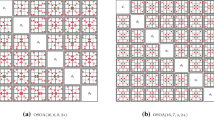Abstract
In this paper we construct all possible orthogonal arrays OA(18,q, 3,2) with 18 runs and 3 ≤ q ≤ 7 columns and present those that are nonisomorphic. A discussion on the novelty and the superiority of many of the designs found in terms of isomorphism and generalized minimum aberration has been made.
Similar content being viewed by others
References
Cheng CS (1995). Some projection properties of orthogonal arrays. Ann Stat 23:1223–1233
Cheng SW, Wu CFJ (2001). Factor screening and response surface exploration (with discussions). Stat Sin 11:553–604
Cheng SW, Ye K (2004) Geometric isomorphism and minimum aberration for factorial designs with quantitative factors. Ann Stat 32:2168–2185
Dey A, Mukerjee R (1999) Fractional factorial plans. Wiley, New York
Evangelaras H, Koukouvinos C, Dean AM, Dingus CA (2005) Projection properties of certain three level orthogonal arrays. Metrika 62:241–257
Evangelaras H, Koukouvinos C, Lappas E (2007) Further contributions to nonisomorphic two level orthogonal arrays. J Stat Plan Inference (in press)
Hedayat AS, Sloane NJA, Stufken J (1999) Orthogonal arrays: theory and applications. Springer, Berlin Heidelberg New York
Li Y (2002) New factorial designs that cannot be embedded into Hadamard matrices. Int Math J 2:527–534
Li Y, Deng L-Y, Tang B (2004) Design catalog based on minimum G-aberration. J Stat Plan Inference 124:219–230
Ma CX, Fang KT (2001) A note on generalized aberration in factorial designs. Metrika 53:85–93
Ma CX, Fang KT, Lin DKJ (2001) On the isomrphism of fractional factorial designs. J Complex 17:86–97
MacWilliams FJ, Sloane NJA (1977) The theory of error-correcting codes. North Holland, Amsterdam
Sun DX, Li W, Ye KQ (2002) An algorithm for sequentially constructing nonisomorphic orthogonal designs and its applications (preprint)
Tsai PW, Gilmour SG, Mead R (2000) Projective three-level main effects designs robust to model uncertainty. Biometrika 87:467–475
Wang JC, Wu CFJ (1995) A hidden projection property of Plackett–Burman and related designs. Stat Sin 5:235–250
Wu CFJ, Hamada M (2000) Experiments: planning, analysis, and parameter design optimization. Wiley, New York
Xu H (2002) An algorithm for constructing orthogonal and nearly orthogonal arrays with mixed levels and small runs. Technometrics 44:356–368
Xu H, Wu CFJ (2001) Generalized minimum aberration for aymmetrical fractional factorial designs. Ann Stat 29:1066–1077
Xu H, Cheng SW, Wu CFJ (2004) Optimal projective three-level designs for factor screening and interaction detection. Technometrics 46:280–292
Author information
Authors and Affiliations
Corresponding author
Rights and permissions
About this article
Cite this article
Evangelaras, H., Koukouvinos, C. & Lappas, E. 18-run nonisomorphic three level orthogonal arrays. Metrika 66, 31–37 (2007). https://doi.org/10.1007/s00184-006-0085-4
Received:
Published:
Issue Date:
DOI: https://doi.org/10.1007/s00184-006-0085-4




